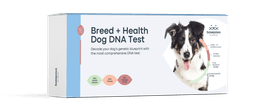Dog breeding is a complex process that requires attention and certain considerations. It should be approached with responsibility and done with safety measures because the mother and puppies' well-being depends on it. Here is all the information you need to recognize the right time to breed your dog, focusing on the estrus cycle and behavioral and physical signs.
3 Main Questions About Dog’s Heat
When does a female dog first come into heat?
The first estrus or heat cycle happens between six months and one year of age. The time depends on the breed and the dog's size. Smaller breeds usually start earlier than bigger ones.
Although pregnancy is possible during the first heat, waiting a second or even a third cycle is better. The dog should be physically and mentally mature to handle pregnancy and motherhood.
How often are dogs in heat?
Most female dogs come into heat approximately every six months, but this can vary. Some may experience a cycle every four months, while others only once a year. Understanding your dog's individual cycle for effective breeding planning is important.
How long are dogs in heat?
The duration of a dog's heat cycle, also known as the estrus cycle, can vary between individuals and breeds, but typically it lasts about 2 to 4 weeks. The estrus cycle has four stages: proestrus, estrus, diestrus, and anestrus. The fertile period usually lasts five to fourteen days during the estrus phase.
Behavioral and Physical Signs of Heat
Recognizing the signs of a dog in heat is essential for determining the optimal breeding time. Here are some typical indications:
Swollen vulva
One of the earliest signs of heat is a swollen vulva. This swelling can be quite noticeable in some dogs, while it might be more subtle in others. This physical change signifies the beginning of the proestrus stage.
Blood or discharge
Another sign is the appearance of a bloody or straw-colored discharge. This discharge typically begins in the proestrus stage and continues into the estrus phase. The color and consistency of the discharge can change as the cycle progresses.
Frequent urination
Increased urination is common during heat. This behavior is part of the dog's natural instinct to advertise her reproductive status to potential mates. But consider that frequent urination is not only about heat, it can be a sign for diabetes, so there should be more signs of the heat.
Excessive licking of the genitals
A dog in heat may lick her genital area more frequently than usual. This behavior responds to the physical changes she is experiencing and helps keep the area clean.
Nervous or aggressive behavior
Some dogs may exhibit changes in behavior, such as being more clingy or, conversely, more aggressive. These mood swings are due to hormonal changes and vary from dog to dog.
Seeking out male dogs
A female dog in heat may show an increased interest in male dogs. This behavior is most pronounced during the estrus phase when she is the most fertile.
Methods to Determine the Best Breeding Time
Vaginal Smear Test: This test involves examining cells from the vaginal wall under a microscope to identify changes that occur during different stages of the heat cycle.
Blood Tests for Hormone Levels: Measuring levels of hormones like progesterone in the blood can help pinpoint the most fertile days in a dog's cycle.
Veterinarian Examination and Ultrasound: A vet can perform a physical examination or use ultrasound to assess changes in the reproductive organs that indicate optimal breeding times.
Responsible Breeding Practices
Responsible breeding is a critical aspect of ensuring the well-being and health of dogs, as well as maintaining the integrity of various breeds. Ethical breeders prioritize the health, temperament, and overall quality of life of the animals they bring into the world. This involves thorough health screenings for genetic conditions, regular veterinary care, and a commitment to promoting the best interests of the dogs.
In addition to prioritizing health, responsible breeders also focus on preventing overpopulation and reducing the number of dogs in shelters. They carefully screen potential owners, ensuring that the dogs they breed are placed in loving and suitable homes. Furthermore, responsible breeders engage in continuous education about breed standards, genetics, and advancements in veterinary care to stay informed and contribute positively to the welfare of their dogs.
Particularly in the context of breeding, genetic tests for dogs serve a crucial role in ensuring the health and vitality of puppies. Breeders can work towards healthier, genetically diverse canine populations by incorporating genetic testing into their breeding programs. These tests are an invaluable tool in responsible breeding practices, contributing to the overall well-being of dogs and the breeds they represent. It can help with:
Identification of genetic diseases;
Breed verification;
Determining genetic traits;
Health and wellness insights;
Inbreeding coefficient.
Conclusion
Understanding the signs and cycles of your dog's heat is crucial for responsible and successful breeding. By recognizing the physical and behavioral changes in your dog, and with the aid of veterinary tests, you can determine the best time to breed your dog. Always consult with a veterinarian to ensure the health and safety of your dog throughout the breeding process. Remember, breeding should always be done with a focus on the well-being of the animals involved, aiming to enhance the breed and not just for the sake of having puppies.
Frequently Asked Questions
Can a dog get pregnant when not in heat?
No, a dog cannot get pregnant when not in heat. Pregnancy can only occur during the estrus stage of the heat cycle when ovulation takes place.
Do dogs have periods?
Dogs do not have periods in the same way humans do, but they experience a heat cycle that includes a phase with vaginal bleeding, known as the proestrus stage.
What age do dogs go into heat?
Dogs typically go into heat for the first time between six months and one year of age, but this can vary depending on the breed and size of the dog.



